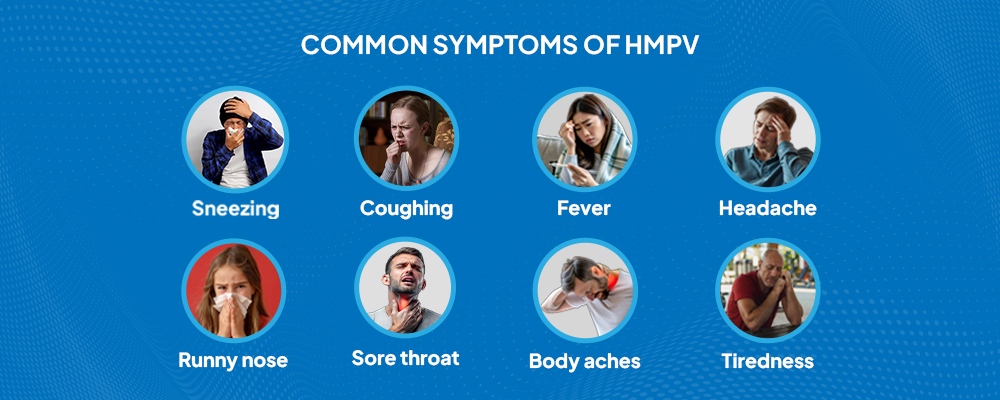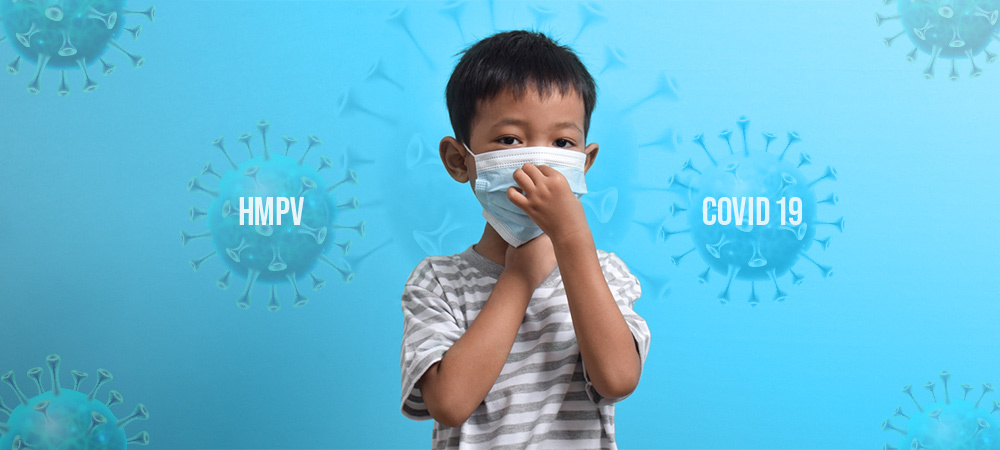Winter is the time when many of us catch common respiratory illnesses like the cold. The cold is usually caused by viruses like rhinovirus and brings symptoms such as a runny nose, sneezing, and a sore throat. These viruses spread quickly, especially during the colder months. Another respiratory illness that’s more common in winter is human metapneumovirus (HMPV). It can cause cold-like symptoms but may lead to more severe complications, especially in vulnerable groups. Knowing about HMPV virus is key to managing its symptoms and safeguarding those who are more vulnerable to its effects.
What Is Human Metapneumovirus (HMPV)?
HMPV is a common respiratory virus that belongs to the pneumoviridae family. It is closely related to respiratory syncytial virus (RSV), another well-known virus in this group. HMPV typically causes mild cold-like symptoms, but it can lead to severe illnesses in certain cases.
Symptoms of Human Metapneumovirus
When infected with HMPV, most people experience mild symptoms like:
- Sneezing
- Coughing
- Runny nose
- Sore throat
- Fever
- Headache
- Body aches
- Tiredness


In rare instances, HMPV can lead to lower respiratory infections, such as:
- Pneumonia
- Asthma flare-ups
- Worsened chronic obstructive pulmonary disease (COPD)
Young children and older adults are more likely to experience severe complications.
Is Human Metapneumovirus Just a Cold?
Although HMPV often mimics the common cold, it is not always as harmless. Children under five years of age are particularly vulnerable to severe illness. Adults over 65 and individuals with breathing problems or compromised immunity are also at higher risk of serious symptoms.
After the first infection, your immune system provides some protection. However, reinfections can still occur, though symptoms are usually milder.
How Common Is Human Metapneumovirus?
HMPV infections are more common than you might think. Research indicates that about 10% to 12% of respiratory illnesses in children are caused by HMPV. Of these cases, 5% to 16% result in lower respiratory tract infections, such as pneumonia.
Infections frequently occur during winter and early spring, similar to the seasonal patterns of other respiratory viruses.
Who Discovered Human Metapneumovirus?
Dutch scientists identified HMPV over 20 years ago, but it has been around for much longer. Evidence suggests that HMPV has been causing respiratory infections worldwide for over 50 years.
Why Understanding HMPV Matters
Raising awareness about HMPV is crucial for protecting vulnerable populations. By practicing good hygiene and recognizing symptoms early, you can reduce the risk of infection.
If you experience severe symptoms, seek medical attention promptly. Early care can prevent complications and promote a faster recovery.
Who Is at Risk for HMPV Virus?
The HMPV virus is more dangerous for certain groups, so understanding its effects is important for staying safe and healthy. While many people experience mild human metapneumovirus symptoms, certain populations are more likely to develop severe complications. These include:
- 1. Children Under Five Years
Human metapneumovirus in kids is particularly concerning because their immune systems are still developing. Young children are more likely to experience severe lower respiratory infections, such as pneumonia, during the early human metapneumovirus stages.
- 2. Elderly Individuals
Older adults face a higher risk due to weaker immune responses. For seniors with pre-existing conditions, the virus can lead to severe symptoms.
- 3. Immunocompromised Patients
Individuals with weakened immune systems, such as those with cancer, HIV, or a history of an organ transplant.
- 4. Individuals with Respiratory Conditions
Underlying conditions like asthma or chronic obstructive pulmonary disease (COPD) can worsen during an infection. The virus often triggers flare-ups or complications.
Human Metapneumovirus vs. COVID-19
HMPV and COVID-19 share several similarities as contagious respiratory illnesses. Both can cause symptoms such as a runny nose, cough, fever, congestion, sore throat, and shortness of breath. They also spread in similar ways, primarily through respiratory droplets and close contact. In severe cases, both can lead to hospitalization.
However, significant differences set these two illnesses apart. Unlike COVID-19, there is currently no antiviral therapy or vaccine available for HMPV. Additionally, HMPV is a seasonal virus that typically peaks in winter and spring, while COVID-19 can circulate year-round due to the emergence of new variants.
| Feature | HMPV | COVID-19 |
|---|---|---|
| Symptoms | Runny nose, cough, fever | Same + loss of taste/smell |
| Seasonality | Peaks in winter/spring | Year-round |
| Treatment | Supportive care, no vaccine | Antivirals, vaccines available |
Research has highlighted an intriguing trend: HMPV cases surged significantly in some regions after the COVID-19 pandemic. During the pandemic, widespread prevention measures like mask-wearing and social distancing reduced exposure to various respiratory viruses, including HMPV. When these precautions were relaxed, respiratory infections such as HMPV saw a sharp increase.
Human Metapneumovirus Precautions
To protect yourself and others, follow these preventive measures:
- Wash your hands frequently with soap and water.
- Avoid close contact with infected individuals.
- Cover your mouth and nose when sneezing or coughing.
How Is Human Metapneumovirus Diagnosed?
Diagnosing the HMPV virus requires a thorough assessment of your symptoms and medical history. Healthcare providers often begin with a physical exam and ask about your personal and family health background.
Diagnostic Tests
To confirm the presence of the virus, doctors may use the following methods:
- Swab Tests: A soft-tipped swab collects samples from your nose, throat, or mouth. These samples are analyzed in a lab to detect HMPV or other infections.
- Rapid Antigen or PCR Testing: These tests quickly identify the virus using advanced laboratory techniques.
It’s important to note that testing for HMPV is usually reserved for severe cases or when symptoms align with advanced human metapneumovirus stages.
Additional Procedures for Severe Symptoms
If you or your child has severe human metapneumovirus symptoms, the following may be required:
- Bronchoscopy: A thin tube with a camera is inserted through the throat to collect fluid samples directly from the airways.
- Chest X-rays: These images help detect changes in the airways caused by the infection.
Management and Treatment of Human Metapneumovirus
Currently, there are no antiviral medications available to treat the HMPV virus. Most individuals can manage their symptoms at home with proper rest, hydration, and over-the-counter remedies to relieve discomfort.
Treatment for Severe Cases
For severe human metapneumovirus symptoms, hospitalization may be necessary. In such cases, healthcare providers focus on supportive care to stabilize the patient and prevent further complications. Common treatments include:
- Oxygen therapy provides extra oxygen through a nasal tube or face mask if breathing becomes difficult.
- IV fluids help maintain hydration and electrolyte balance.
- Corticosteroids reduce inflammation and might alleviate severe respiratory symptoms.
Are Antibiotics Needed?
Antibiotics are not effective against human metapneumovirus because it is caused by a virus, not bacteria. However, in cases where HMPV leads to secondary bacterial infections, such as pneumonia, antibiotics may be prescribed to address the bacterial component.
The Role of Clinical Trials in Advancing Pulmonology Health
Clinical trials play a vital role in advancing treatments and improving outcomes for various health conditions. For pulmonology diseases and lung cancers, these trials provide critical insights into new therapies, diagnostic tools, and preventive measures. Many clinical research institutes are actively conducting studies in this area, giving patients access to potential treatments and helping improve medical care.
Conclusion:
In conclusion, HMPV is a common respiratory virus that can cause mild to severe symptoms, especially in high-risk groups like young children, older adults, and individuals with weakened immune systems. While there is no specific antiviral treatment, most people recover with proper care and rest. Practicing good hygiene, recognizing symptoms early, and seeking timely medical care can help prevent complications. Continued research and clinical trials are essential to improving treatments for HMPV and related respiratory conditions.




